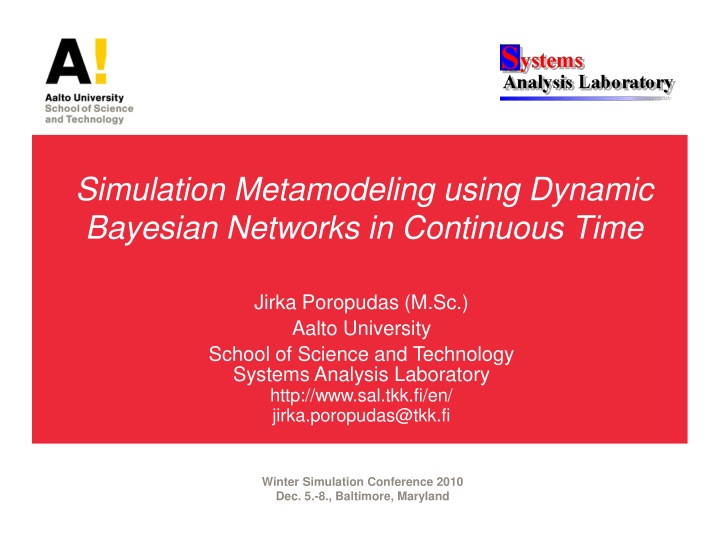
Dynamic Bayesian Networks in Continuous Time for Simulation Metamodeling
Explore how Dynamic Bayesian Networks (DBNs) are utilized as simulation metamodels in continuous time, allowing for the time evolution of discrete event simulations. The construction, utilization, and approximate results of DBNs are elaborated, with insights into their application in scenarios like air combat simulations. Learn about the joint probability distribution of random variables, the concept of time slices, and the integration of simulation parameters for what-if analysis and conditional probability distributions.
Download Presentation

Please find below an Image/Link to download the presentation.
The content on the website is provided AS IS for your information and personal use only. It may not be sold, licensed, or shared on other websites without obtaining consent from the author. If you encounter any issues during the download, it is possible that the publisher has removed the file from their server.
You are allowed to download the files provided on this website for personal or commercial use, subject to the condition that they are used lawfully. All files are the property of their respective owners.
The content on the website is provided AS IS for your information and personal use only. It may not be sold, licensed, or shared on other websites without obtaining consent from the author.
E N D
Presentation Transcript
Simulation Metamodeling using Dynamic Bayesian Networks in Continuous Time Jirka Poropudas (M.Sc.) Aalto University School of Science and Technology Systems Analysis Laboratory http://www.sal.tkk.fi/en/ jirka.poropudas@tkk.fi Winter Simulation Conference 2010 Dec. 5.-8., Baltimore, Maryland
Contribution Dynamic Bayesian network: Metamodel for the time evolution of discrete event simulation Previously: Changes in probability distribution of simulation state presented in discrete time Now: Extension to continuous time using interpolation
Outline Dynamic Bayesian networks (DBNs) as simulation metamodels Construction of DBNs Utilization of DBNs Approximative results in continuous time using interpolation Example analysis: Air combat simulation Conclusions
Dynamic Bayesian Network (DBN) Joint probability distribution of a sequence of random variables Simulation state variables Nodes Dependencies Arcs Conditional probability tables Time slices Discrete time Simulation state at
Dynamic Bayesian Networks in Simulation Metamodeling Poropudas J., Virtanen K., 2010. Simulation Metamodeling with Dynamic Bayesian Networks, submitted for publication. Time evolution of simulation Probability distribution of simulation state at discrete times Simulation parameters Included as random variables What-if analysis Simulation state at time t is fixed Conditional probability distributions
Construction of DBN Metamodel Poropudas J.,Virtanen K., 2010. Simulation Metamodeling with Dynamic Bayesian Networks, submitted for publication. 1) Selection of variables 2) Collecting simulation data 3) Optimal selection of time instants 4) Determination of network structure 5) Estimation of probability tables 6) Inclusion of simulation parameters 7) Validation
Optimal Selection of Time Instants Probability curves estimated from simulation data DBN gives probabilities at discrete times Piecewise linear interpolation
Optimization Problem Minimize maximal absolute error of approximation Solved using genetic algorithm MINIMIZE
Approximative Reasoning in Continuous Time DBN gives probabilities at discrete time instants What-if analysis at these times Approximative probabilities for all time instants with first order Lagrange interpolating polynomials What-if analysis at arbitrary time instants Simple, yet effective!
Example: Air Combat Simulation X-Brawler discrete event simulation model for air combat 1 versus1 air combat State of air combat Neutral: and Blue advantage: and Red advantage: and Mutual disadvantage: and
Time Evolution of Air Combat neutral red blue mutual What happens during the combat?
What-if Analysis neutral red blue neutral mutual red blue mutual What if Blue is still alive after 225 seconds?
Simulation Data versus Approximation Similar results with less effort
Conclusions Dynamic Bayesian networks in simulation metamodeling Time evolution of simulation Simulation parameters as random variables What-if analysis Approximation of probabilities with first order Lagrange interpolating polynomials Accurate and reliable results What-if analysis at arbitrary time instants without increasing the size of the network Generalization of simulation results
Future research DBN metamodeling Error bounds? Comparison with continuous time BNs Piecewise linear interpolation not included in available BN software Simulation metamodeling using influence diagrams Decision making problems Optimal decision suggestions Influence Diagram
References Friedman, L. W. 1996. The simulation metamodel. Norwell, MA: Kluwer Academic Publishers. Goldberg, D. E. 1989. Genetic algorithms in search, optimization, and machine learning. Upper Saddle River, NJ: Addison-Wesley Professional. Jensen, F. V., and T. D. Nielsen. 2007. Bayesian networks and decision graphs. New York, NY: Springer- Verlag. Nodelman, U.D., C.R. Shelton, and D. Koller. 2002. Continuous time Bayesian networks. Eighteenth Conference on Uncertainty in Artificial Intelligence. Pearl, J. 1991. Probabilistic reasoning in intelligent systems: Networks of plausible inference. San Mateo, CA: Morgan Kaufmann. Phillips, G. M. 2003. Interpolation and approximation by polynomials. New York, NY: Springer-Verlag. Poropudas, J., and K. Virtanen. 2007. Analysis of discrete events simulation results using dynamic Bayesian networks , Winter Simulation Conference 2007. Poropudas, J., and K. Virtanen. 2009. Influence diagrams in analysis of discrete event simulation data, Winter Simulation Conference 2009. Poropudas, J., and K. Virtanen. 2010. Simulation metamodeling with dynamic Bayesian networks, submitted for publication. Poropudas, J., J. Pousi, and K. Virtanen. 2010. Simulation metamodeling with influence diagrams, manuscript.
